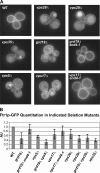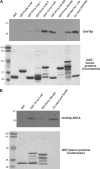Grd19/Snx3p functions as a cargo-specific adapter for retromer-dependent endocytic recycling
- PMID: 17420293
- PMCID: PMC2064116
- DOI: 10.1083/jcb.200609161
Grd19/Snx3p functions as a cargo-specific adapter for retromer-dependent endocytic recycling
Abstract
Amajor function of the endocytic system is the sorting of cargo to various organelles. Endocytic sorting of the yeast reductive iron transporter, which is composed of the Fet3 and Ftr1 proteins, is regulated by available iron. When iron is provided to iron-starved cells, Fet3p-Ftr1p is targeted to the lysosome-like vacuole and degraded. In contrast, when iron is not available, Fet3p-Ftr1p is maintained on the plasma membrane via an endocytic recycling pathway requiring the sorting nexin Grd19/Snx3p, the pentameric retromer complex, and the Ypt6p Golgi Rab GTPase module. A recycling signal in Ftr1p was identified and found to bind directly to Grd19/Snx3p. Retromer and Grd19/Snx3p partially colocalize to tubular endosomes, where they are physically associated. After export from the endosome, Fet3p-Ftr1p transits through the Golgi apparatus for resecretion. Thus, Grd19/Snx3p, functions as a cargo-specific adapter for the retromer complex, establishing a precedent for a mechanism by which sorting nexins expand the repertoire of retromer-dependent cargos.
Figures







Similar articles
-
Opposing activities of the Snx3-retromer complex and ESCRT proteins mediate regulated cargo sorting at a common endosome.Mol Biol Cell. 2008 Nov;19(11):4694-706. doi: 10.1091/mbc.e08-03-0296. Epub 2008 Sep 3. Mol Biol Cell. 2008. PMID: 18768754 Free PMC article.
-
Post-transcriptional regulation of the yeast high affinity iron transport system.J Biol Chem. 2005 Jun 10;280(23):22181-90. doi: 10.1074/jbc.M414663200. Epub 2005 Apr 7. J Biol Chem. 2005. PMID: 15817488
-
Alpha-synuclein inhibits Snx3-retromer-mediated retrograde recycling of iron transporters in S. cerevisiae and C. elegans models of Parkinson's disease.Hum Mol Genet. 2018 May 1;27(9):1514-1532. doi: 10.1093/hmg/ddy059. Hum Mol Genet. 2018. PMID: 29452354
-
Retromer and sorting nexins in endosomal sorting.Biochem Soc Trans. 2015 Feb;43(1):33-47. doi: 10.1042/BST20140290. Biochem Soc Trans. 2015. PMID: 25619244 Review.
-
Retrograde trafficking and plasma membrane recycling pathways of the budding yeast Saccharomyces cerevisiae.Traffic. 2020 Jan;21(1):45-59. doi: 10.1111/tra.12693. Epub 2019 Oct 1. Traffic. 2020. PMID: 31471931 Review.
Cited by
-
Analysis of the SNARE Stx8 recycling reveals that the retromer-sorting motif has undergone evolutionary divergence.PLoS Genet. 2021 Mar 31;17(3):e1009463. doi: 10.1371/journal.pgen.1009463. eCollection 2021 Mar. PLoS Genet. 2021. PMID: 33788833 Free PMC article.
-
Endomembrane-associated RSD-3 is important for RNAi induced by extracellular silencing RNA in both somatic and germ cells of Caenorhabditis elegans.Sci Rep. 2016 Jun 16;6:28198. doi: 10.1038/srep28198. Sci Rep. 2016. PMID: 27306325 Free PMC article.
-
A mechanism for retromer endosomal coat complex assembly with cargo.Proc Natl Acad Sci U S A. 2014 Jan 7;111(1):267-72. doi: 10.1073/pnas.1316482111. Epub 2013 Dec 16. Proc Natl Acad Sci U S A. 2014. PMID: 24344282 Free PMC article.
-
Exo-endocytic trafficking and the septin-based diffusion barrier are required for the maintenance of Cdc42p polarization during budding yeast asymmetric growth.Mol Biol Cell. 2011 Mar 1;22(5):624-33. doi: 10.1091/mbc.E10-06-0484. Epub 2011 Jan 5. Mol Biol Cell. 2011. PMID: 21209323 Free PMC article.
-
ARF1 localizes to the golgi and the trans-golgi network.Plant Cell. 2011 Mar;23(3):846-9; author reply 849-50. doi: 10.1105/tpc.110.082099. Epub 2011 Mar 15. Plant Cell. 2011. PMID: 21406621 Free PMC article. No abstract available.
References
-
- Askwith, C., D. Eide, A. Van Ho, P.S. Bernard, L. Li, S. Davis-Kaplan, D.M. Sipe, and J. Kaplan. 1994. The FET3 gene of S. cerevisiae encodes a multicopper oxidase required for ferrous iron uptake. Cell. 76:403–410. - PubMed
-
- Bonifacino, J.S., and R. Rojas. 2006. Retrograde transport from endosomes to the trans-Golgi network. Nat. Rev. Mol. Cell Biol. 7:568–579. - PubMed
Publication types
MeSH terms
Substances
Grants and funding
LinkOut - more resources
Full Text Sources
Other Literature Sources
Molecular Biology Databases

